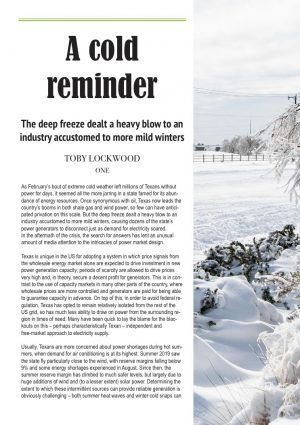 As February’s bout of extreme cold weather left millions of Texans without power for days, it seemed all the more jarring in a state famed for its abundance of energy resources. Once synonymous with oil, Texas now leads the country’s booms in both shale gas and wind power, so few can have anticipated privation on this scale. But the deep freeze dealt a heavy blow to an industry accustomed to more mild winters, causing dozens of the state’s power generators to disconnect just as demand for electricity soared.
As February’s bout of extreme cold weather left millions of Texans without power for days, it seemed all the more jarring in a state famed for its abundance of energy resources. Once synonymous with oil, Texas now leads the country’s booms in both shale gas and wind power, so few can have anticipated privation on this scale. But the deep freeze dealt a heavy blow to an industry accustomed to more mild winters, causing dozens of the state’s power generators to disconnect just as demand for electricity soared.
In the aftermath of the crisis, the search for answers has lent an unusual amount of media attention to the intricacies of power market design.
Texas is unique in the US for adopting a system in which price signals from the wholesale energy market alone are expected to drive investment in new power generation capacity; periods of scarcity are allowed to drive prices very high and, in theory, secure a decent profit for generators. This is in contrast to the use of capacity markets in many other parts of the country, where wholesale prices are more controlled and generators are paid for being able to guarantee capacity in advance. On top of this, in order to avoid federal regulation, Texas has opted to remain relatively isolated from the rest of the US grid, so has much less ability to draw on power from the surrounding region in times of need. Many have been quick to lay the blame for the blackouts on this – perhaps characteristically Texan – independent and free-market approach to electricity supply.
Usually, Texans are more concerned about power shortages during hot summers, when demand for air conditioning is at its highest. Summer 2019 saw the state fly particularly close to the wind, with reserve margins falling below 9% and some energy shortages experienced in August. Since then, the summer reserve margin has climbed to much safer levels, but largely due to huge additions of wind and (to a lesser extent) solar power. Determining the extent to which these intermittent sources can provide reliable generation is obviously challenging – both summer heat waves and winter cold snaps can be associated with little wind and, in the case of winter, very little sun. Texas has increasingly relied on natural gas for more dependable capacity, reaching over 45% of generation in 2020, while coal has fallen to 18% and wind climbed to 23%. But investment in new gas capacity is thought to have been inadequate in recent years, even as demand in the state has grown.
Nevertheless, the state should have had enough conventional power plants on the grid to deal with demand during the cold snap. Worst-case scenario forecasting by the grid operator ‘ERCOT’ naturally assumes minimal contribution from wind. However, around 30 GW of generators – mainly gas, but also wind, coal, and nuclear – went offline due to a combination of cold-induced technical failures at plants (such as freezing pipes or instrumentation) and a shortage of gas supply.
There was also a sizeable portion of plants undergoing scheduled maintenance over what is normally expected to be a quiet period. This dramatic loss of available generators left the operator with no option but to drop consumers from the grid.
The issue of gas shortages in cold weather has become a hot topic in the US over the last decade, particularly following another famous ‘polar vortex’ cold snap in 2014, which mostly affected north-eastern states. Unlike summer demand peaks, cold weather brings high demand for gas for both power and heating and, when combined with freeze-ups at production wells and pipelines, can lead to astronomical gas prices and supply shortages for generators. Following the 2014 event, several north-eastern grids beefed up their existing capacity markets by requiring generators to prove their resilience to cold weather through steps such as securing alternative fuel supplies or long-term gas contracts.
Texas may not have a capacity market, but state regulators have made some efforts to improve mandatory winter-proofing of power plants and gas infrastructure following a near-miss cold-weather event in 2011. Much of the fall-out around the February blackouts has centred on why more regulation was not imposed, or why industry has resisted it.
Northern regions prove that it is perfectly possible to make this infrastructure more resilient to extreme weather, but it will come at a cost, and perhaps one that is harder for generators to justify in an ERCOT-style market. After all, scarcity events represent a vital pay day for generators in Texas (provided they remain online), so the market arguably tends towards such close calls.
Inevitably, backers of various energy sources have been quick to use the crisis to highlight the weakness of competitors – wind turbines can freeze, gas is vulnerable to shortages, even coal and nuclear were affected.
However, there is more to take from this than a simple acceptance of the fallibility of all types of energy. Thermal plant can clearly be vulnerable to cold, but adequate regulation and technical measures offer a ready solution. On the other hand, there is no question of relying on wind and solar to ride out such a storm. The grid still needs to ensure that there is always sufficient ‘firm’ capacity to meet almost all the peak demand if necessary and this is highly challenging – particularly without recourse to a capacity market.
Advocates for both renewables and the ‘energy-only’ market model often point to greater use of smarter energy grids with more opportunity for demand response, in which users can offer to reduce consumption for a fee. While this must surely form part of the future of electricity, it may have more limited use during winter shortages, when reducing consumption has more serious implications than simply turning down the air con. The other rapidly emerging option is the development of large-scale energy storage technologies, but again, the Texas event represents a formidable task for this approach. Delivering several days of unusually high demand would require an enormous quantity of stored energy – potentially in a long-term form such as hydrogen – as well as enough excess generation beforehand to build up supplies.
So, the Texas crisis is perhaps a warning that we are a long way from being able to entirely dispense with conventional power plants. It has also raised some fundamental questions over how much risk we are willing to accept with our electricity supply, how much we are willing to pay to minimise that risk, and whether we trust existing markets to deliver the best compromise. On paper, the ‘one day of blackout in ten years’ level of assurance used by many grid operators sounds manageable, but a serious system failure in the depths of a cold winter may have consequences which society deems unacceptable at any price. As power grids undergo a rapid evolution to more dynamic, less predictable systems with much more weather-dependent generation, these questions will only become harder to address.
Toby Lockwood





